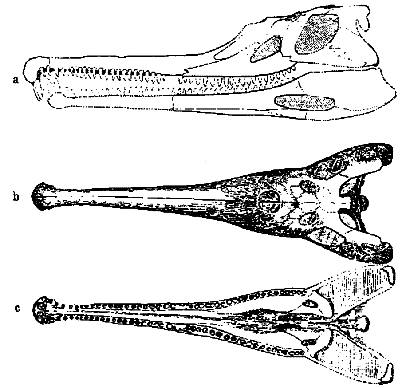
| Late Triassic Epoch | ||
| Mesozoic: Triassic Period |
Rhaetian Age - 2 |
Pachystropheus rhaeticus from the Late Rhaetian Penarth Group of South-West England, is the earliest known example of the Choristodera. It represents one of a number of lizard-analogues that populated the Late Triassic (others include sphenodonts, Prolacertiformes, and drepanosaurs, and kuehnosaurs). Much later In the Late Cretaceous and Early Tertiary, choristoderes will experience a brief resurgence as semi-aquatic crocodile-like reptiles.
Pachystropheus's identification as a choristodere 45 million years earlier than the next oldest representation of the group supports the validity of cladistics as a tool for suggesting the diversity of extinct organisms in terms of Ghost lineages. [Storrs and Gower 1993]
 |
|
illustration from xxxx
|
Angistorhinopsis ruetimeyeri (also known as Rutiodon ruetimeyeri, although true Rutiodon is limited to the latest Carnian [Lucas 1998] is a large long-snouted form known from the latest Norian and Rhaetian and Europe, where it replaces the earlier genera the earlier Mystriosuchus and Nicrosaurus in the same way that in south-west North America Redondasaurus replaces Pseudopalatus. It is not known however if Anghistorhinopsis and Redondasaurus are related. Anghistorhinopsis was originally named by von Huene for its supposed resemblance to the Latest Carnian genus Angistorhinus Later (in 1936) he erected the family Angistorhinidae to include Promystriosuchus, Angistorhinus and Angistorhinopsis. Promystriosuchus [Creisler 1996]., but this would seem to be an artificial grouping, although the name Angistorhinidae is still sometimes used. In nay case, the presence of Angistorhinopsis ruetimeyeri in the German Rhaetian (and similar teeth in the French early Rhaetian deposits of Saint-Nicolas-de-Point [Sigogneau-Russell and Hahn 1994]) shows that these large animals continued to flourish throughout the latest Triassic.
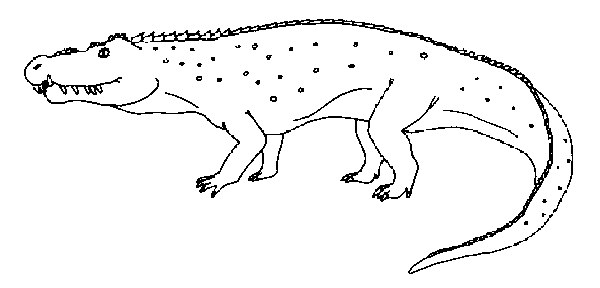 |
|
drawing © 2001 Vince R Ward - Prehistoric Pages
|
Riojasuchus was a medium-sized terrestrial carnivore, about 2 meters in length. This animal was a cousin of the Late Carnian Ornithosuchus, although a bit smaller in size. These were active, fast-moving animals, with fully erect and upright posture, just like dinosaurs, mammals, and Prestosuchia/Rausichia.
Riojasuchus has been found associated with Hemiprotosuchus, Pseudohesperosuchus, and c.f. Tritylodon [Bonaparte 1970]
 |
|
illustration by M. Alan Kazlev -
Creative Commons License 2005
|
Fasolasuchus tenax was one of the last of the Rauisuchians, and also the largest. This animal had a skull alone that was 1.3 meters in length, which, assuming similar proportions with Saurosuchus, means an overall length of 8 or 10 meters, the size of a large theropod dinosaur. In fact, apart from the large theropods, Fasolasuchus was perhaps the largest fully terrestrial predators ever (both large phytosaurs and "super crocs" were bigger, but they were also semi-aquatic). It is likely that this animal was specialized for feeding on large sauropodomorphs, which raises the question of whether similar giant rauisuchians lived elsewhere.
In the (Late Norian) Lower Elliott formation of South Africa a jawbone (maxilla) and the ends of a femur have been attributed to a giant allosaur-sized, about 1.5 tonnes) Herrerasaur (Aliwalia rex.) In view of the fact that no theropod of this size is known from Triassic rocks (whereas giant Rauisuchians are) it is more likely that this is a Teratosaurus-like chimera, with the maxilla belonging to a large rauisuchid. In view of the close geographic and temporal proximity, this may well imply that Aliwalia was a close relative (perhaps even belonging to the same genus) as Fasolasuchus [Bonaparte 1976, Bonaparte 1981, Bonaparte 1982]
 |
|
drawing © 2001 Vince R Ward - Prehistoric Pages |
Although common and widespread from the Carnian to the middle Norian, the Aetosaurs seem to have declined thereafter. In Europe no aetosaur is known from later than the Middle Norian, and it seems that the group was limited to western Pangea. Neoaetosauroides engaeus Bonaparte 1967 is known from postcrania, jaws, and skull fragments the Upper beds of the Los Colorados Formation (Latest Norian and/or Rhaetic) , La Rioja Province, Argentina, where it is found associated with Riojasaurus [Bonaparte 1970]. It was a small and persistently primitive aetosaur, about 1.5 meters in length. Along with the large and advanced Paratypothorax, found to the north (Chinle Formation of North America), and the small Redondosuchus, these are the only aetosaurs known from the Late Norian/Rhaetian.
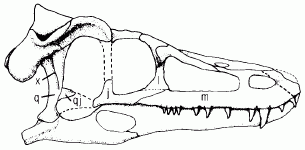 |
|
illustration from Clark et al 2000 |
Pseudohesperosuchus jachaleri, from the Los Colorados formation of Argentina, was a Gondwanan representative of the graceful and lightly built sphenosuchians that were an important element in the late Triassic - early Jurassic terrestrial microvertebrate faunas. The lightly built skull is elongate and slender, as are the limb bones. Pseudohesperosuchus was probably similar in appearance to, and closely related to, the European Saltoposuchus/Terrestrisuchus. Pseudohesperosuchus has been found associated with Riojasuchus, Hemiprotosuchus, and c.f. Tritylodon [Bonaparte 1970]
 |
|
drawing © 2001 Vince R Ward - Prehistoric Pages |
Hemiprotosuchus leali is another reptile known from the rich fossil assemblages of the Los Colorados formation of Argentina. It is the earliest known representative of the Protosuchidae, a group otherwise known only from the Jurassic. The presence of such a typically early Jurassic form in the latest Triassic shows the transitional nature of the Los Colorados fauna. Hemiprotosuchus differed from its distant crocodylomorph cousin and contemporary Pseudohesperosuchus in its shorter, more massive, and typically protosuchian skull. If it is typical of its group, the limbs were shorter too, and the body stockier. Hemiprotosuchus differs from the early Jurassic Protosuchus in the presence of an opening before the eyes, a "primitive" archosaurian feature. Hemiprotosuchus has been found associated with Riojasuchus, Pseudohesperosuchus, and c.f. Tritylodon [Bonaparte 1970]. The presence here of Riojasuchus (family Ornithosuchidae) shows that these must be Triassic deposits, because the ornithosuchids, like other large "thecodonts" (Crurotarsal) are completely unknown after the Rhaetian
 |
|
drawing © 2001 Vince R Ward - Prehistoric Pages
|
Riojasaurus incertus was a large (length 6 to 10 meters) and common animal known from over twenty partial skeletons and a single skull, from the Los Colorados [sometimes considered late Norian but more likely (in view of advanced faunal elements) Rhaetian] of Argentina. It seems to have been the dominant herbivore of the Southwest Gondwana, the ecological equivalent of the Late Norian to Rhaetian Plateosaurus and the Late Norian (to Rhaetian?) Euskelosaurus, which we can assume were contemporary. Although for some time considered a typical "melanorosaurid"—perhaps on the basis of its large size and quadrupedal stance—it is now known to be a Prosauropod sensu stricta (plateosaur). It is clear that there were a large number of sauropodomorph lineages evolving parallel to each other during this period.
This gentle giant must have lived in large herds, sharing its environment with other sauropodomorphs like the plateosaur Coloradisaurus brevis and the early sauropod Lessemsaurus sauropoides, along with smaller archosaurs like Neoaetosauroides. But even their large size could not protect them from the gigantic rauisuchian Fasolasuchus, the only real predator of these large herbivores
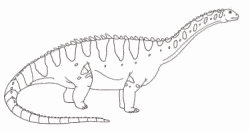 |
|
drawing © 2001 Vince R Ward - Prehistoric Pages |
Isanosaurus attavipachi, from the Rhaetian Nam Phong Formation of Thailand, is one of the earliest-known sauropods [Mortimer 2000]. Its partial postcranial remains provided the first osteological evidence of pre-Jurassic sauropods. Since the discovery of the even earlier Antetonitrus, it is no longer considered the earliest sauropod Holtz 2003. Isanosaurus differs markedly from prosauropods and confirmed the cladistic hypothesis of a fairly long period of sauropod evolution during the Triassic [Buffetaut et al 2000]. The animal is estimated to have been about 6.5 meters long when alive, and seems to have been a sub-adult
Isanosaurus was not the only early sauropod or proto-sauropod of its time. The 9 meter long Camelotia borealis from the Rhaetian of England is a rather poorly known (some assorted postcrania) Melanorosaurid, or possibly a basal sauropod. And Lessemsaurus sauropoides, based on a partial vertebral column from Los Colorados, Argentina, was originally considered a melanorosaurid but is now considered an early true sauropod close to Antetonitrus.
Isanosaurus by Luis Rey
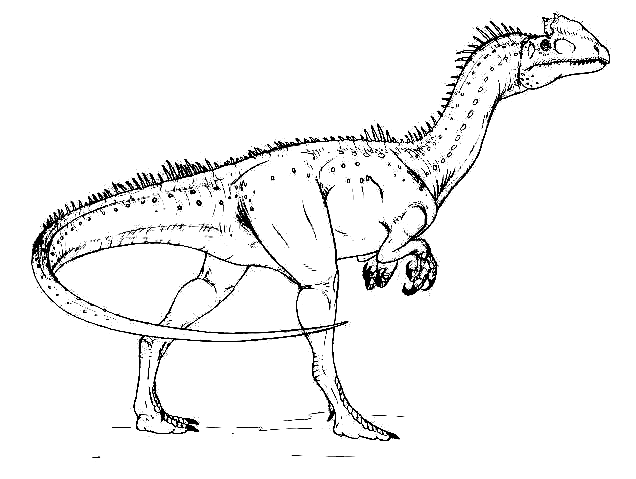 |
|
illustration copyright © 2005 Gabriel Lio.
|
Zupaysaurus rougieri is a large (skull estimated total length 45cm) early theropod recently (2003) described from the Los Colorados Formation, La Rioja Province, Argentina [Arcucci and Coria 2003]. It was originally though to have been the earliest known and most basal tetanuran, but it now seems to be a coelophysoid that independently evolved certain tetanuran characteristics. The neck was quite long, and the head decorated by paired crests (probably for intra-specific display). These animals would have fed on smaller sauropodomorphs, and the young of larger animals like Riojasaurus
 |
drawing modified from original by Vince R Ward - Prehistoric Pages
|
Not all Traversodontidae were large. Microscalenodon, known from isolated teeth from the Rhaetian fissure deposits of Belgium and France, was a rare late surviving tiny traversodont, which presumably filled the same role as small rodents. It was probably about the size of a shrew or a small mouse
Microscalenodon nanus
Gaume, Habay-le-Vielle, Belgium and Saint-Nicolas-de-Point in France
Late Norian/early Raetian to Rhaetian
about the size of a mouse
small rodent
known remains consist of isolated teeth
 |
|
drawing modified from original by Vince R Ward - Prehistoric Pages
|
Although it is known only from isolated teeth, that is enough to tell that Meurthodon was a giant among Rhaetian synapsids (cynodonts and proto-mammals). Based on the size of the largest fossil teeth, this critter might have reached 30 to 40 centimetres in length. It was big enough to have fed not only on invertebrates but also on smaller vertebrates.
Because nothing is known of this animal other than some postcanine teeth - which show similarities to both the advanced Carnian cynodont Therioherpeton and the basal mammal Sinemurian Sinoconodon, it is difficult to know where it belongs on the synapsid evolutionary tree. The molars are more advanced and mammal-like than those of Therioherpeton in that they have two roots, but not yet at the mammal level. So it is not possible to determine whether Meurthodon is a very advanced cynodont or a true early mammal, and it has been provisionally referred to the Dromatheriidae, although - in view of its large size, it may also be an advanced and late-persisting member of the Therioherpetidae
After Meurthodon, no synapsid carnivore would exceed the size of a large mouse until the late Jurassic.
Meurthodon gallicus
Saint-Nicolas-de-Point in France
Late Norian/early Rhaetian
body length from 30 to 40 cm
insectivore / small carnivore (probably nocturnal)
known remains consist of isolated teeth
 |
|
drawing modified from original by Vince R Ward - Prehistoric Pages |
The Dromatheriidae were a group of tiny insectivorous cynodonts very close to the mammals ins structure, and known only from isolated teeth. Tricuspes tuebingensis E. v. Huene, 1933, Tricuspes sigogneauae Hahn, Hahn et Godefroit, 1994, Tricuspes tapeinodon Godefroit & Battail 1997, and Pseudotriconodon wildi Hahn G, Lepage J & Wouters G, 1984 are all known from the fissure fillings of Saint-Nicolas-de-Port, France (Late Norian or early Rhaetian), and are also known from Luxembourg, Germany, and (Pseudotriconodon sp.) Belgium. Clearly there was a very diverse and common mammal-like cynodont and proto-mammalian microfauna prominent at this time. For data on these little animals (such as there is) we can do no better than refer the reader to Trevor Dykes coverage on the Dromatheriidae, which also includes the original journal reference listing of each species, along with other information.
Godefroit & Battail 1997; Trevor Dykes Chiniquodontoidea,
 |
|
drawing © 2001 Vince R Ward - Prehistoric Pages |
The morganucodontids - represented by genera like Eozostrodon, Morganucodon, Hallautherium, Helviotodon, and Brachyzostrodon, from Anglo-Welsh fissure fillings and Rhaetic (or latest-Norian-Rhaetic) deposits and bone-beds of Greenland, Switzerland and France - were the most primitive of the true mammals. Along with the haramiyids, they were the most common of the early mammalian taxa during the Latest Norian and Rhaetian, although, as with all these tiny animals, they are known chiefly from isolated teeth. These shrew-like and probably nocturnal insectivores must have been an important element in the microvertebrate fauna, rustling through the undergrowth of central north Pangaea. Although traditionally included in the order Triconodonta on the basis of dental characteristics, they appear to be far more primitive than later Jurassic members of the group. morganucodontids seem to have ranged in size from 30 to 90g, the equivalent of between one and four standard house mice. For more details, see Trevor Dykes Mesozoic MAMMALS; Basal Mammaliaformes, Morganucodontidae, Megazostrodontidae and Hadrocodium, an internet directory
 |
|
drawing © 2001 Vince R Ward - Prehistoric Pages |
Thomasia is a representative of a group of very early mammalian herbivores that with one exception (Haramiyavia) are known only from isolated cheek teeth found in the fissure fillings of France, England and Germany. Rather confusingly, the name Haramiya Simpson, 1947 was given to upper teeth, and Thomasia Poche, 1908 to lower teeth, and it was thought that these belonged to different animals. Haramiya became better known, and lent its name to the family Haramiyidae and the order Haramiyida. Recently it has been argued that these are the same animal, and so the newer name, Harimiya becomes a junior synonym for Thomasia (which, being the older name, has priority). The change of name does not cover supra-generic nomenclature, so the names Haramiyidae and Haramiyida remain valid.
Because these broad cheek teeth resemble those of recent voles, it is usually reconstructed as a miniature vole. Of course there is guarantee this is what it actually looked like, and study of Haramiyavia will no doubt provide a different picture. It is however most likely that it was a herbivore, living on low growing vegetation.
Haramiyids were originally considered ancestral to the multituberculates, an important group of rodent-like mammals of the Mesozoic and early Tertiary. The current majority view rejects this position, and considers them an early mammaliform offshoot unrelated to multituberculates, although a persisting minority view retains their relationship with the multituberculates, or sees them as a paraphyletic ancestral grade of multituberculates.
These animals seem to have been quite common but limited to north-central Pangea. A number of species known from the Late Norian/early Rhaetian to Sinemurian of central-north Pangea (Western Europe): Thomasia antiqua (Late Norian/early Rhaetian to ?Sinemurian of England & France & Switzerland - see data panel, right), Thomasia hahni Late Norian/early Rhaetian of Germany, Thomasia moorei (Late Norian/early Rhaetian to ?Sinemurian of England & France & Switzerland), Thomasia wouteri (Rhaetian of Belgium), Haramiyavia clemmenseni (Late Triassic ?or Early Jurassic of eastern Greenland) (the best known member of the family, known from a jaw with teeth in place, and some postcrania, sometimes placed in its own family), Mojo usuratus (Rhaetian of Belgium, sometimes considered related to the near to the multituberculate family Paulchoffatiidae, although this is debatable), and Theroteinus nikolai (Late Norian/early Rhaetian of France). For more details, see Trevor Dykes Mesozoic MAMMALS; Haramiyida, an internet directory
page uploaded May 2005
text content by M. Alan Kazlev